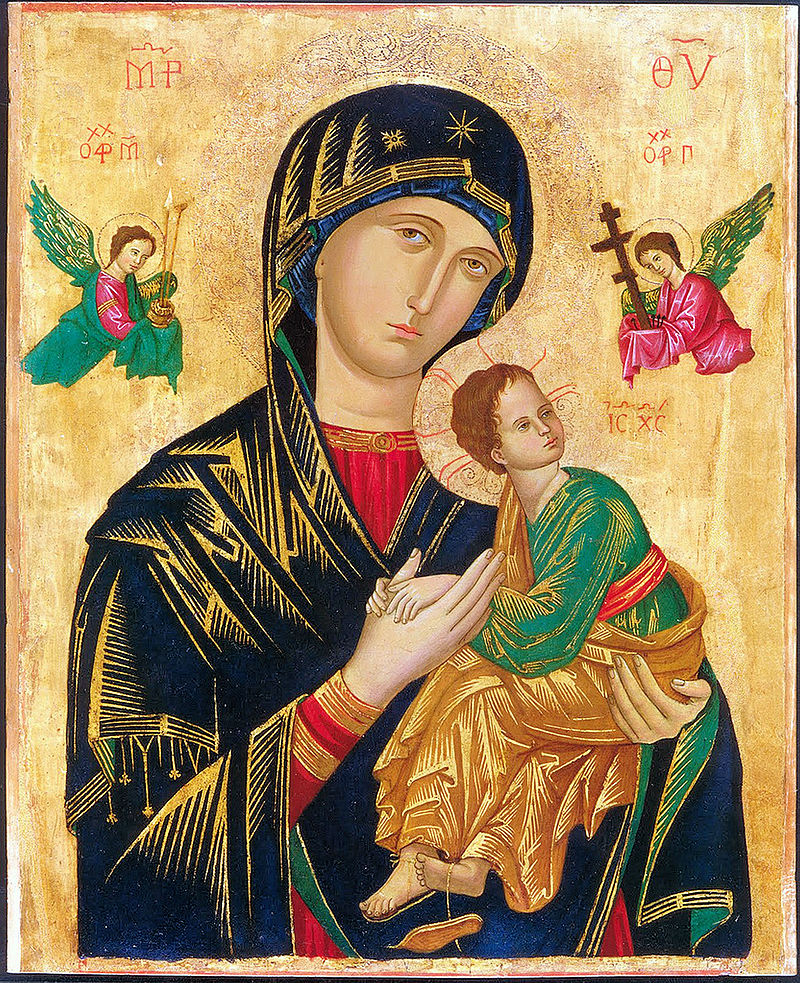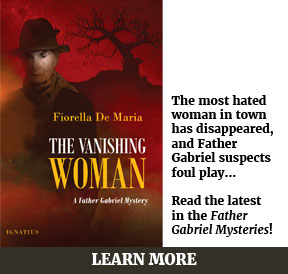As a child my family had the usual comforting Christmas rituals: watching It’s a Wonderful Life, listening to Handel’s Messiah, decorating the tree, baking cookies, wrapping presents. The licorice smell of anise-flavored springerle cookies, the taste of gingerbread, the sound of the voices as they announce the coming of the baby called Wonderful, Counsellor. All of these can instantly evoke the joy and comfort of being a child at Christmas, screwing up my nearsighted eyes at the lights on the tree and dreaming up worlds lit by candles and colorful glass globes.
As an adult I watched It’s a Wonderful Life with friends and marveled at the darkness I had missed as a child. The fear and rage that George Bailey feels, the weight of grief at lost chances, the humiliation of ambition thwarted. The furious anger that is unleashed as George lashes out at friends and family. The end provides consolation, but leaves the pain and sorrow intact.
 In traditional depictions of the Virgin and Child, there is always a reminder that despite the joy of his birth, the sorrow and pain of torture and death are to come for the Child. Sometimes it’s a goldfinch that the Child plays with, the finch being a bird that feeds upon thorny plants, foreshadowing the thorns which will be forced down upon that Child’s brow when he is a man. Sometimes it is a thorn bush looming over the mother and Child. Sometimes angels hover, bearing with them the lance that will pierce the Child’s side and the nails which will be hammered through his hands. The mother who holds her Son and kisses his cheek will one day hold the broken body of a man who has been tormented and shamed, put to death by the people he has come to redeem. We know that the resurrection will provide consolation, but the sorrow will always be there as well, consoled but not removed. Even after resurrection, Christ still displays his wounds for us to see.
In traditional depictions of the Virgin and Child, there is always a reminder that despite the joy of his birth, the sorrow and pain of torture and death are to come for the Child. Sometimes it’s a goldfinch that the Child plays with, the finch being a bird that feeds upon thorny plants, foreshadowing the thorns which will be forced down upon that Child’s brow when he is a man. Sometimes it is a thorn bush looming over the mother and Child. Sometimes angels hover, bearing with them the lance that will pierce the Child’s side and the nails which will be hammered through his hands. The mother who holds her Son and kisses his cheek will one day hold the broken body of a man who has been tormented and shamed, put to death by the people he has come to redeem. We know that the resurrection will provide consolation, but the sorrow will always be there as well, consoled but not removed. Even after resurrection, Christ still displays his wounds for us to see.
It’s often hard for those who love and receive boundless cheer from the Christmas season to remember that sorrow might be rearing its head for others. There are many for whom the Christmas season is a time of anxiety, of grief, and of sorrow. Those evocative scents and sounds and images can dredge up pain just as easily as they bring forth cheer.
But can we reconcile joy and sorrow? Perhaps, but only if we allow that it is in the coming of Christ that we find that consolation, and that we can allow ourselves to acknowledge grief, pain, and depression as part of the condition Christ comes to console, and that it is only human to allow ourselves to express these feelings.
The writer J.R.R. Tolkien once wrote to his son about the death and resurrection of Christ creating a “Christian joy which produces tears because it is qualitatively so like sorrow, because it comes from those places where Joy and Sorrow are at one, reconciled, as selfishness and altruism are lost in Love.” May we allow ourselves to be lost in Love this Christmas, and pray that all those in darkness may be consoled by the Child and his mother, and find their sorrow reconciled with joy.






Robert Hill
December 18, 2014 at 11:05 pm
Very timely. My father died on the feast of Epiphany, just as I was leaving childhood, so I think I understand better than I might otherwise; but all that is good in this life comes with the certainty that it will end. This makes the prospect of paradise all the sweeter. I am going to watch It’s a Wonderful Life with my family now. Godspeed.
John Herreid
December 19, 2014 at 4:23 pm
Thanks, Robert! I think sometimes we aren’t very good in this day and age at acknowledging the need to let people grieve or feel sadness. The emphasis on being cheerful at all times makes a lot of people end up feeling guilty about being sad, rather than accepting it as a normal part of life.
LuMahino
December 19, 2014 at 9:48 pm
Thank you so much for a very timely reminder.
irene
December 19, 2014 at 10:05 pm
John, this is exactly how I feel. I feel joy, the miracle of His birth. At the same time, as a mother, my heart breaks, knowing the pain that is to come. As I listen to the glorious hymns of the proclamation of His birth, I cry tears of joy for His birth at the same time I cry tears of pain for the loss that is to come. You described it perfectly. Beautiful.
John Herreid
December 19, 2014 at 10:57 pm
Thanks, Irene!
Margaret Neumann
December 20, 2014 at 6:59 am
that was a beautiful reminder of how special Christmas really is.
The Darkness of Christmas – Article – Life + Love + Loss
February 28, 2016 at 10:00 am
[…] The Darkness of Christmas […]